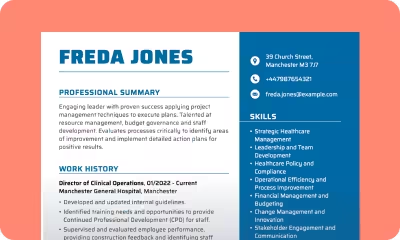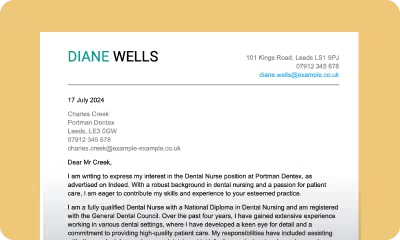- Our customers have been hired by : *Foot Note
Artists play a vital role in a number of sectors, helping businesses realise their vision with high-quality illustrations, graphic designs, and other media. Whether internal or external, artists require a number of skills – in particular, creative flair, communication, and the ability to follow a brief.
The perfect artist’s CV neatly illustrates your creativity plus your professionalism. Using a clear format, your artist CV should highlight your best skills, attributes, and experience in similar roles. It will also speak to key on-the-job skills like time management, branding, and attention to detail.
This guide will show you how to create a CV that showcases your artistic talents while presenting yourself as a reliable and adaptable professional. You’ll learn how to format and structure your CV, highlight relevant experience, and communicate your unique creative vision through your job application.
Thanks to our winning CV examples, you can create a job application that lands you your next interview in no time. Keep reading for:
- Sample artist CV
- Artist CV templates
- The best format for your artist CV
- How to write an effective CV for an artist
- Top dos and don’ts for artist CV writing
- Your artist CV questions answered
SEARCH ALL CV EXAMPLES
Sample artist CV
Kevin Knight
99 Cunnery Road
Manchester MAN M37GJ
07912 345678
kevin.knight@example-example.co.uk
Professional summary
Detail-oriented Illustrator offering outstanding creativity and technical mindset. Promoting extensive background in media and fine arts and foundation in colour theory, composition, lighting, and form. Successful career history spanning 11+ years.
Work history
02/2018 – Current
Pen to Paper Design Services | Manchester, Greater Manchester
Illustrator
- Created a wide variety of original pieces of artwork suitable for print and digital publications.
- Combined hand-drawing and painting with digital media to create complete illustrations.
- Carefully prepared all design layouts into prepress files for offset, web, and digital printing.
01/2013 – 01/2018
Manchester Museum | Manchester, Greater Manchester
Gallery Manager
- Implemented innovative art programmes to increase visitor numbers and grow the positive reputation of the museum.
- Trained, coached, and mentored staff to ensure the smooth adoption of new programmes and informed them about new special events.
- Maximised profitability, promoting services at relevant conferences, workshops, and meetings.
12/2010 – 01/2013
York Museum | York, Yorkshire
Gallery Assistant
- Greeted and welcomed all visitors in a friendly manner.
- Led tours around the gallery and facilitated large visitor groups.
- Employed approved solvents and cleansers to ready items for display.
Skills
- Strong attention to detail
- Excellent communication skills
- Superior time management
- Project management and organisation skills
- Adobe Photoshop and InDesign proficiency
- Mac OS X proficient
- Corporate identity branding and advertisement
Education
2010
University of Manchester | Manchester
MA: Art Gallery and Museum Studies
2009
Manchester Metropolitan University | Manchester
BA (Hons): Fine Art
The best format for your artist CV
When creating an artist CV, choosing the right format is essential to showcasing your talent and experience. Two common CV formats – reverse chronological and skills-based – each offer unique benefits depending on your career stage and goals.
For experienced artists, a reverse chronological format is often ideal. It prioritises your most recent roles, making it easy for recruiters to see your most recent achievements and career progression. This format is clear and helps to highlight relevant roles that demonstrate your growth as an artist.
However, a skills-based CV may be more effective if you’re an emerging artist or transitioning into the field. Also known as a functional CV, this format organises your CV around your key skills rather than your career history. It’s perfect for highlighting transferable skills, such as teamwork or communication, as well as for minimising employment gaps and tailoring your CV to specific opportunities.
Here are some general tips to help you format your artist CV:
- Showcase your artistic range: Whether you use a chronological or skills-based format, make sure your portfolio and artistic achievements are highlighted. Include links to online portfolios, exhibitions, or work demonstrating your versatility.
- Tailor to specific roles: Depending on the role you’re applying for, consider highlighting different skills or experience. A reverse chronological format may be best for showcasing your past exhibitions or projects, while a skills-based CV allows you to highlight your creativity, artistic process, or collaborative skills for non-traditional roles.
- Focus on your medium and style: Be sure to list the mediums you work in, such as painting, sculpture, digital art, etc. This can be emphasised in either format, but it’s particularly important in a skills-based CV to show your mastery of different artistic tools.
- Highlight transferable skills: Even for established artists, there may be skills from previous roles outside your artistic career that apply, such as project management, teaching, or curating. A skills-based format allows you to focus on these competencies while minimising the emphasis on employment gaps.
How to write an effective CV for an artist
With a scarcity of art roles comes a lot of competition. Your CV is the first chance you have to set yourself apart from other candidates and demonstrate your value to recruiters. Read our step-by-step guide to find out how you can do exactly that. This section will cover:
- Adding contact details to your artist CV
- Writing your artist CV’s personal statement
- Adding an experience section to your artist CV
- Top skills for your artist CV
- Outlining education on an artist CV
Adding contact details to your artist CV
Start your CV by writing your personal and contact information at the top of the page. Include your full name in the first line. Then, enter your contact details: address, phone number, and email.
As an artist, it’s important to demonstrate your specialism and previous art projects. Make sure you include a link to your portfolio in this section – something that’s hard to find on a standard CV in industries such as sales or retail.
Example of contact section for an artist CV
Kevin Knight
99 Cunnery Road
Manchester MAN M37GJ
07912 345678
kevin.knight@example-example.co.uk
kevinknight-artist.co.uk/portfolio
Writing your artist CV’s personal statement
The personal statement is one of the essential parts of an artist CV. This is where you explain what makes you different, and artists need to convey their creative passion and desire to create great art.
If your CV is your portfolio, your personal statement is the front cover. Also known as a professional summary, it provides an introduction for recruiters, telling them what they can expect from your CV and your work more broadly.
A great artist’s personal statement should highlight your top skills as an artist, experience in specific areas like branding, and the kind of companies you’ve worked with or projects you’ve successfully completed. Be sure to include some personal qualities like communication, attention to detail, and creative flair – to paint the full picture for recruiters.
Example of personal statement for an artist CV
Accomplished jazz musician with over 15 years of experience performing at iconic venues such as the Royal Albert Hall and the London Jazz Festival. Known for innovative compositions and dynamic performances, my work has been featured on BBC Radio 3. Committed to nurturing talent, actively mentoring emerging artists and collaborating on projects that push the boundaries of jazz.
OR
Emerging artist working in mixed media exploring themes of identity and cultural heritage. Recent exhibitions include the Community Arts Centre’s “New Voices” showcase, with a focus on creating thought-provoking and emotionally resonant work. Dedicated to experimentation and growth, seeking opportunities to connect with diverse audiences through exhibitions and collaborations.
Adding an experience section to your artist CV
Just as a beautiful piece of art captivates an audience, your artist CV’s work experience section should highlight the defining moments of your career to stand out. Rather than simply listing exhibitions or roles, focus on experience and achievements that illustrate your impact as an artist.
You can mention the solo exhibition where your work sold out, a residency that shaped your practice, or an art project for a client that helped them successfully rebrand. These achievements can also be expanded upon in your cover letter, where a link to your portfolio of website will help recruiters learn more about your talent.
Example of work experience for an artist CV
02/2018 – Current
Pen to Paper Design Services | Manchester, Greater Manchester
Illustrator
- Created a wide variety of original pieces of artwork suitable for print and digital publications.
- Combined hand-drawing and painting with digital media to create complete illustrations.
- Carefully prepared all design layouts into prepress files for offset, web, and digital printing.
01/2013 – 01/2018
Manchester Museum | Manchester, Greater Manchester
Gallery Manager
- Implemented innovative art programmes to increase visitor numbers and grow the museum’s positive reputation.
- Trained, coached, and mentored staff to ensure the smooth adoption of new programmes and informed them about new special events.
- Maximised profitability, promoting services at relevant conferences, workshops, and meetings.
12/2010 – 01/2013
York Museum | York, Yorkshire
Gallery Assistant
- Greeted and welcomed all visitors in a friendly manner.
- Led tours around the gallery and facilitated large visitor groups.
- Employed approved solvents and cleansers to ready items for display.
Top skills for your artist CV
A strong artist CV should demonstrate both your technical skills and your ability to connect with your desired audience and collaborators. Key skills to showcase in your job application include a deep understanding of artistic principles and techniques and transferable skills such as effective communication and project management. If you’re a digital artist, make sure to also list the software tools you can use, such as Photoshop, Illustrator, or 3ds Max.
As a successful artist, you combine creativity with organisational skills to produce work that’s not only visually, musically, or conceptually appealing but also professionally executed and delivered on time. Transferable skills such as collaboration, adaptability, and problem solving are essential for building relationships with clients, curators, galleries, or directors.
In the world of art, your talent and dedication matter the most. You need to show recruiters that you can produce great work daily and meet the role’s precise needs.
Essential skills for an artist
- Artistic skills: drawing, painting, sculpture, printmaking, or digital media
- Artistic techniques: expertise in chosen mediums and contemporary art methods
- Project management: ability to manage multiple projects, exhibitions, and deadlines
- Studio or stock management: organisational skills for managing materials, inventory, and workspace
- Digital tools: proficiency in software such as Adobe Photoshop, Illustrator, or 3D modelling tools
Desirable aptitudes to set you apart
- Creativity: innovation in concept and execution
- Communication skills: ability to clearly articulate ideas to collaborators, curators, or clients
- Problem-solving: finding creative solutions to artistic or logistical challenges
- Attention to detail: precision in artwork and presentations
- Time management: balancing multiple exhibitions or commissions without compromising quality
- Collaboration: strong interpersonal skills for working with diverse teams, curators, or other artists
Outlining education on an artist CV
As an artist, it’s understandable that you might not put too much weight on qualifications. After all, they aren’t what sets you apart. However, recruiters usually like to see them to tick a box and make sure you meet the role’s requirements. Whether it’s an A-level in Art or a degree in Art History, a clearly presented qualifications section adds credibility to your CV. It can help you make connections between your academic background and your practice.
When listing your qualifications, start with the most recent or highest level achieved. Include the name of the degree or certificate, the institution, and the dates of study. If your academic experience includes any particularly relevant modules, awards, or projects, consider briefly mentioning these. For example, you could write: “Focused on mixed media sculpture and installation art” or “Final project exhibited at Tate Modern’s ‘New Artists’ showcase”.
For artists who may not have formal qualifications, consider listing other forms of training, such as workshops, residencies or mentorships. By thoughtfully presenting your training, you’ll show potential employers and collaborators that you have a well-rounded foundation, while keeping the focus on your unique artistic achievements.
Example of education for an artist CV
2010
University of Manchester | Manchester
MA: Art Gallery and Museum Studies
2009
Manchester Metropolitan University | Manchester
BA (Hons): Fine Art
2022
London Print Studio | London
Printmaking Residency
Top dos and don’ts for artist CV writing
Do
DO let your talent shine
A great way to show off your talent to prospective recruiters is to make sure you list any exhibitions, publications, awards, or even commissions you’ve received. If your art has been recognised and appreciated on a professional scale, you need to get that point across throughout your CV.
DO keep your artist CV tidy
Artists naturally tend to have an eye for detail and a desire to make their work look beautiful. You can apply this aesthetic appreciation to your CV. A recruiter with an eye for the arts will notice a CV that has been beautifully put together with neat lists and tidy paragraphs.
Don't
DON'T hold back
Depending on the type of work you’re applying for, you might be tempted to only focus on particular skills and experience that seem relevant to the position. However, you shouldn’t hold back on details that could make you stand out. For example, you speak another language, which could be useful to an employer.
DON'T forget about artist keywords
With such a wide range of artist roles on offer, it’s important that your CV is tailored to your specialist abilities and experience. Part of this is hitting the keywords used in the job description to pass the applicant tracking system (ATS) that many recruiters use for artist jobs.
Your artist CV questions answered
What should be included in an artist CV?
An artist CV should include the standard CV information, like your contact details and work history, along with a personal statement that exemplifies your passion for art and creativity. You should also mention awards and exhibitions you’ve been involved in.
What should an artist CV look like?
Since art-related roles typically involve a crucial focus on appearance and aesthetics, an artist CV needs to be well-presented. You may choose to add a splash of colour in the headings, but it’s not recommended to go too far with this. Try to strike a balance between professionalism and creativity.
How long should my artist CV be?
Your artist CV should normally be one page long. It should provide a concise yet comprehensive overview of your artistic career, highlighting key exhibitions, achievements, training, and skills. For more experienced artists, a two-page CV is acceptable to include a wider range of exhibitions, residencies, awards, and collaborations. Keep it focused, organised, and easy to read.
Should I include a portfolio with my artist job application?
Yes, you should always include a portfolio with your application as an artist. A portfolio is essential as it showcases your work and demonstrates your artistic style, technical ability, and range. It should be tailored to the specific job or opportunity you’re applying for, with relevant pieces that best reflect your skills and artistic approach. Whether it’s a digital or physical portfolio, make sure it’s professionally presented and easy for the reviewer to navigate. If you’re submitting a digital portfolio, include a link to your website or online platform and make sure your portfolio is well-organised and current.
Should I include personal projects or unpaid work on my artist CV?
Yes, personal projects and unpaid work can be important, especially if they demonstrate your artistic skills or align with the role’s requirements. These projects can highlight your passion, initiative, and versatility, which are valuable to potential employers or collaborators.
Should I include references on my artist CV?
It’s not always necessary to include references directly on your CV unless specifically requested. However, you can put “References available on request” at the end of your CV or provide them separately if asked.
How do I organise my artist CV if I have multiple artistic disciplines?
If you work across several disciplines – such as painting, sculpture, and digital art – you can create separate sections or subheadings under your CV to clearly show each area of expertise. For example, you could have categories such as “Painting”, “Sculpture”, and “Digital Art”, each with its own exhibitions, awards, and skills.
Build your artist CV today
To secure an artist role, you need a strong CV that stands out from the crowd. We can help you put together a perfect artist CV and have the best chances of success.
With myPerfectCV, it couldn’t be easier. Choose the right CV template for your artist role, then use our CV builder to customise it with pre-written content, including artist skills and experience.
*The names and logos of the companies referred to above are all trademarks of their respective holders. Unless specifically stated otherwise, such references are not intended to imply any affiliation or association with myperfectCV.




